|
A Toy Salute to Uncle Sam
by Bob Brooke
Everyone has heard of Uncle Sam. And while this
name may not roll off the tongues of most people today, it was very
popular from the early 19th century to the mid-20th
century. But who was this character and where did he come from? And
how did his image get on 19th-century cast-iron banks?
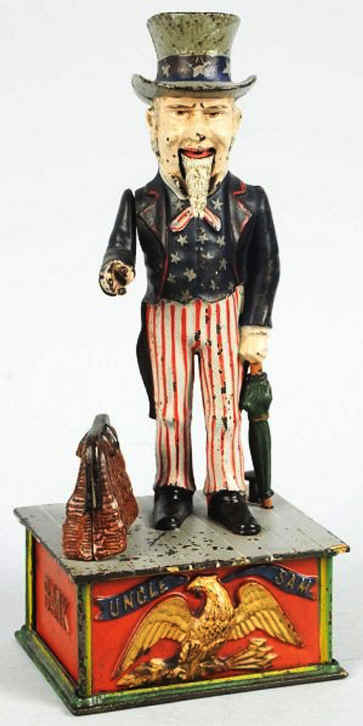 Supposedly,
the term Uncle Sam came from Samuel Wilson, a meat packer from Troy,
New York who supplied barrels of beef and pork to the U.S. Army during
the War of 1812. There was a requirement at the time for food
purveyors to stamp their name and where the rations came from onto the
food they were sending. Wilson labeled his packages "E.A Ė
US." Supposedly,
the term Uncle Sam came from Samuel Wilson, a meat packer from Troy,
New York who supplied barrels of beef and pork to the U.S. Army during
the War of 1812. There was a requirement at the time for food
purveyors to stamp their name and where the rations came from onto the
food they were sending. Wilson labeled his packages "E.A Ė
US."
During a routine check on Sam Wilsonís meat
packing plant, government inspectors, along with a soldier named
Pheodorus Bailey, spotted the stacks of crates marked "U.S."
and wanted to know what it meant. A meat packer, either with a sense
of humor, or not knowing the true meaning of the letters, informed the
officials they must be the initials of his employer, "Uncle
Sam."
The soldiers began referring to the grub as
"Uncle Samís." The local newspaper picked up on the story,
and Uncle Sam eventually gained widespread acceptance as the nickname
for the U.S. Government.
Samuel Wilson was born on Sept. 13, 1766 in
Massachusetts at a little place called Menotomy, which has since been
renamed Arlington. He became a patriot very early on. When Sam was 8
years old, he became a drummer boy. A year later he warned everyone in
the village that the Redcoats were coming by beating on his drum while
on duty in Menotomyís village green. By the time he had turned 14,
Wilson joined the army and saw active service.
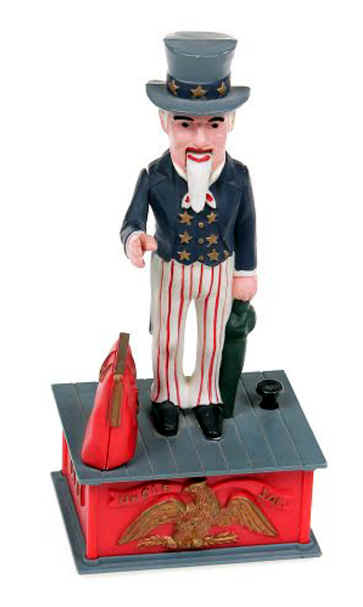 He
was 23 in 1789 when he moved to Troy, New York, where he started a
meat packaging company. He became well respected for his fair and
honest ways and his business flourished. A friendly, happy and
convivial man, he was soon affectionately referred to as "Uncle
Sam" by the locals. He
was 23 in 1789 when he moved to Troy, New York, where he started a
meat packaging company. He became well respected for his fair and
honest ways and his business flourished. A friendly, happy and
convivial man, he was soon affectionately referred to as "Uncle
Sam" by the locals.
Samuel Wilson went on to become active in politics
after the War of 1812 and led a full and happy life. He died On July
31, 1854 at age 87. He may have been forgotten in the rest of the
country as the original Uncle Sam but not in Troy, N.Y. In 1931, the
town erected a tombstone in Oakwood Cemetery which reads: "In
loving memory of Uncle Sam, the name originating with Samuel
Wilson."
There are two memorials to Uncle Sam, both of which
commemorate the life of Samuel Wilsonóthe Uncle Sam Memorial Statue
in Arlington, Massachusetts, his birthplace, and a memorial near his
long-term residence in Riverfront Park, Troy, New York.
In September 1961, the U.S. Congress recognized
Samuel Wilson as "the progenitor of Americaís national symbol
of Uncle Sam." He was buried next to his wife Betsey Mann in the
Oakwood Cemetery in Troy, New York, the town that calls itself
"The Home of Uncle Sam."
Images of Uncle Sam
By 1820 New England newspapers began including
illustrations of Uncle Sam. These early drawings show him as a
clean-shaven man dressed in a black top hat and tails. The colorful
image we know as Uncle Sam today came about over the years, with
additions by various illustrators.
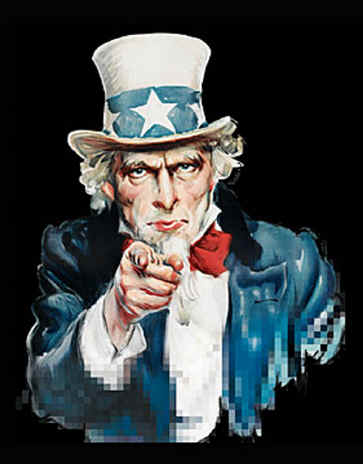 When
Andrew Jackson was president, artists gave Uncle Sam red pants. The
long beard sprouted during Abraham Lincoln's tenure, as a sort of
homage to the president. When
Andrew Jackson was president, artists gave Uncle Sam red pants. The
long beard sprouted during Abraham Lincoln's tenure, as a sort of
homage to the president.
But it wasnít until the late 19th
century that artists decided to dress the popular character
patriotically. They added white stripes to his red pants and added
stars and stripes to his top hat. His clothes started to resemble the
National Flag, and soon he became a short, plump and flamboyantly
dressed figure.
The noted cartoonist and illustrator, Frank H.T.
Bellew was, at one time, thought to have created the first published
form of Uncle Sam, but his rendition of the character didnít appear
in print until 1852.
In the late 1860s and 1870s, political cartoonist
Thomas Nast, the same artist who created the image of Santa Claus,
began popularizing the image of Uncle Sam. Nast continued to evolve
the image, eventually giving Sam the white beard and stars-and-stripes
suit that everyone associates with him today. He depicted Uncle Sam as
very tall and thin with sunken cheeks. His drawings were the closest
to Samuel Wilson, although Nast had modeled his version on Abraham
Lincoln.
The most recognizable Uncle Sam and the one that
has been most reproduced, is that of James Montgomery Flagg. He
created his version as a self portrait. This is the famous dour faced,
finger-pointing figure that appeared on World War I posters with the
caption "I want you for U.S. Army." The poster sold 4
million copies during the First World War and another half million
during World War II.
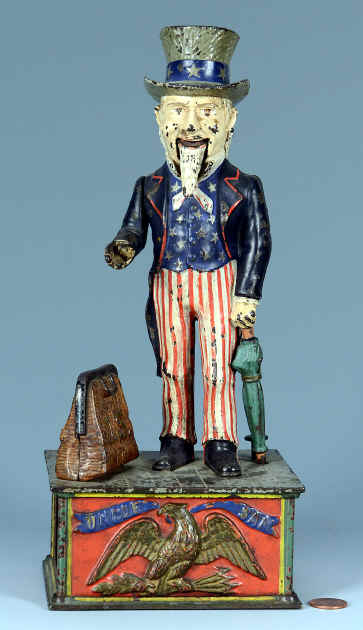 Uncle
Sam didnít get a standard appearance until the noted
"recruitment" image of Uncle Sam, created by James
Montgomery Flagg, inspired by a British recruitment poster showing
Lord Kitchener in a similar pose. The immensely popular image first
appeared on the cover of Leslieís Weekly in July 1916 with
the title "What Are You Doing for Preparedness?" It was this
image more than any other that set the appearance of Uncle Samóthe
elderly man with white hair and a goatee, wearing a white top hat with
white stars on a blue band, a blue tail coat, and red and white
striped trousers. In one year, from 1917 to 1918, over four million
copies of the image were reproduced. Uncle
Sam didnít get a standard appearance until the noted
"recruitment" image of Uncle Sam, created by James
Montgomery Flagg, inspired by a British recruitment poster showing
Lord Kitchener in a similar pose. The immensely popular image first
appeared on the cover of Leslieís Weekly in July 1916 with
the title "What Are You Doing for Preparedness?" It was this
image more than any other that set the appearance of Uncle Samóthe
elderly man with white hair and a goatee, wearing a white top hat with
white stars on a blue band, a blue tail coat, and red and white
striped trousers. In one year, from 1917 to 1918, over four million
copies of the image were reproduced.
The U.S. Army used Flagg's image again during World
War II, during which the German intelligence agency Abwehr codenamed
the U.S. "Samland." The term also appeared in the lyrics of
the song "The Yankee Doodle Boy", featured in the musical
"Yankee Doodle Dandy" in 1942.
Uncle Sam Banks
But toy cast-iron banks depicting Uncle Sam are
probably the most popular among collectors. Peter Adams Jr. and
Charles G. Shepard created the first Uncle Sam bank. But it was the
Shepard Hardware Company of Buffalo, New York that produced the first
one in 1886. This particular cast-iron mechanical bank features an
umbrella-carrying Uncle Sam standing on a decorated base holding a
suitcase. By placing a coin in his hand and pressing the knob on the
box, Uncle Sam lowers his arm and puts the money into the U.S Treasury
bag. The beard on his lower jaw moves as if heís talking.
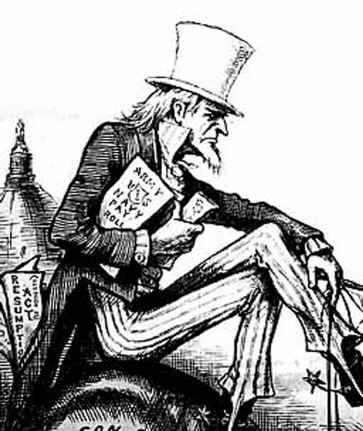 At
the time it appeared on the market, the bank showed Uncle Sam, who
represented the U.S. Government, taking citizens' money. At
the time it appeared on the market, the bank showed Uncle Sam, who
represented the U.S. Government, taking citizens' money.
Toy banks became popular in the United States
during the 18th century after hard currency went into circulation. But
it wasnít until the early part of the 19th century that the first
chartered savings bank in New York City opened its doors. Being
thrifty soon became a popular trend, and people began using toy banks
as a way to follow the encouraging words of Benjamin Franklinó"A
penny saved is a penny earned."
Fakes and Reproductions
If Uncle Samís beard moves as the coin in his
spring-loaded hand drops into the U.S. Treasury bag at his feet, then
the bank is authentic.
Many reproductions have been made since the first
Uncle Sam bank. Those produced in the 1920s may still hold
considerable value, but never as much as the original. The most recent
large scale production of these banks occurred during the U.S.
Bicentennial celebration in 1976. But manufacturers cut corners and
didnít make these banks from real cast iron, choosing to use a
lighter, cheaper metal instead. These cheap knockoffs also had more
details than the originals. While some look similar to the originals,
most can be spotted by the addition of embellishments and added
details.
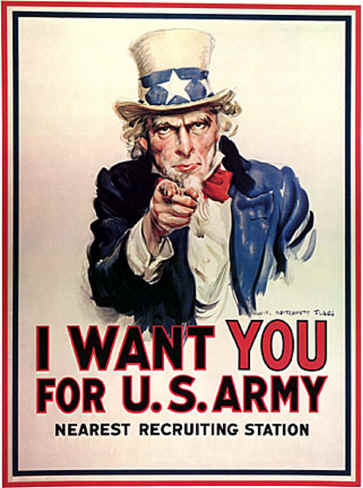 If
a bank is heavy, itís probably an early reproduction. Also, if the
paint is really bright, it most likely is a later reproduction. Some
people have repainted originals, but this is a mistake and ruins their
value. Some reproductions also have incorrect colors. The correct
colors should be a blue full dress coat with red and white striped
pants. On the bottom of the base should be the words, "PAT. JUNE
8, 1886". Most reproductions show the mark, "Made in
Korea" or "Made in China." But some reproductions only
have an eagle and banners on one side. On the original they appear on
both sides. The beard moves on the originals but doesnít move on
many reproductions. A modern reproduction, made in Taiwan, sells for
only about $15 to $25. If
a bank is heavy, itís probably an early reproduction. Also, if the
paint is really bright, it most likely is a later reproduction. Some
people have repainted originals, but this is a mistake and ruins their
value. Some reproductions also have incorrect colors. The correct
colors should be a blue full dress coat with red and white striped
pants. On the bottom of the base should be the words, "PAT. JUNE
8, 1886". Most reproductions show the mark, "Made in
Korea" or "Made in China." But some reproductions only
have an eagle and banners on one side. On the original they appear on
both sides. The beard moves on the originals but doesnít move on
many reproductions. A modern reproduction, made in Taiwan, sells for
only about $15 to $25.
The value of these banks is always dependent on
their condition, but many of the originals have little paint left on
them. In good working condition and with all of its original paint, an
1886 bank could be worth $1,000 and as much $18,000.
PHOTO CAPTIONS: Top to Bottom
Toy banks depicting Uncle Sam are probably the most popular among
collectors.
The most recent large scale production of Uncle Sam banks occurred
during the U.S. Bicentennial celebration in 1976.
The most recognizable Uncle Sam and the one that has been most
reproduced, is that of James Montgomery Flagg.
The Shepard Hardware Company of Buffalo, New York produced the
first Uncle Sam bank in 1886.
In the late 1860s and 1870s, political cartoonist Thomas Nast, the
same artist who created the image of Santa Claus, began popularizing
the image of Uncle Sam.
Uncle Sam didnít get a standard appearance until the noted
"recruitment" image of Uncle Sam, created by James
Montgomery Flagg |